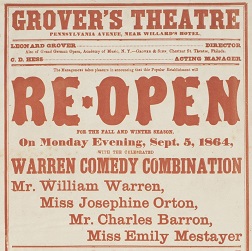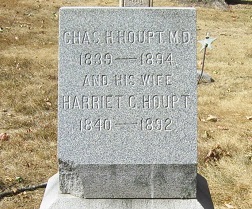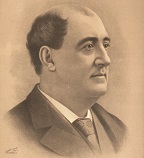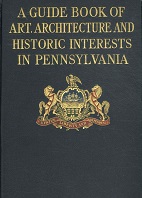
|
John 'Jacob' Houpt |
John "Jacob" Houpt was born on April 27, 1776 in or near Durham, Bucks County, PA, the son of John "Henry" Sebastian and Maria Catharina (Youngken) Haupt Jr.
He grew up as the son of stern taskmaster. He and his brothers "were kept so strictly and severely at work, that each of them, as he came of age, went out of the homestead to work for himself... [to] escape from parental control," recalled a descendant. "It is commonly said that the Bucks County Haupts went north, south, east and west." Jacob went on to impose the same harsh discipline on his own brood of children and showed little if any affection.
Jacob as a bachelor relocated to Philadelphia in 1791 and spent seven years engaged as an accountant and clerk. Then after his sister Sarah married Abraham Piesch, a ship-owner, Jacob went to work in the family business. Piesch owned several vessels which carried goods to and from China. But in 1798, during a period of hostility with France, all of the firm's vessels were captured or destroyed. When peace was negotiated in 1800, the French were absolved from any liability for American shipping losses. Piesch sued for restitution, but it took more than 100 years to resolve the claims, and, says the book That Man Haupt, "all the supporting papers had been lost."
Despite the financial disaster, Jacob kept faith in his brother-in-law's business acumen and used an inheritance from his late father's estate to invest more capital. Three of his brothers did likewise. The Piesch business resumed its shipping activity in the Far East. But during the War of 1812, some 15 of its ships near the Philadelphia port were captured in a British blockade, crushing the partners and ending their work together. Jacob found some way to earn a living after that as a merchant.
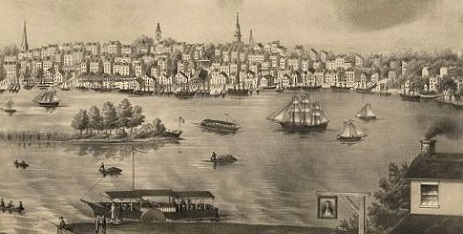 |
| Old Philadelphia, including a stereoview of the Betsy Ross house - Library of Congress |
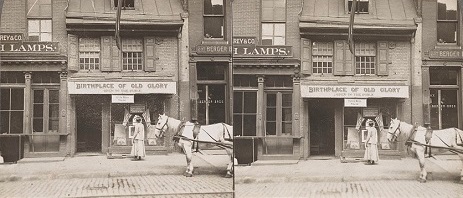 |
Circa 1816, in Philadelphia, the 40-year-old Jacob married a Houpt cousin, 30-year-old Anna Margaretta (Wiall) Snyder (July 22, 1786-1857), daughter of Peter and Elizabeth (Houpt) Wiall. She had been divorced the previous year from her husband, Andrew Snyder, on the complaint that he treated her excessively badly and with "gross infidelity."
Anna thus brought a stepson to the marriage, Charles Jacob Snyder, with the boy later taking on the Houpt name.
The children borne by this union were Gen. Herman Haupt (Lincoln's "Railroad Man"), Ellen Haupt, Henrietta Bennett Archambault, Thomas Jefferson Haupt, Jacob "Lewis" Leeds Haupt and Mary Elizabeth Haupt. Daughter Ellen passed away at the age of three.
Jacob as a family man found a position as a bookkeeper for a wholesale grocery in Philadelphia, and his bride operated a small dry goods business. Then in 1825 he and Henry D. Steever opened their own grocery together.
Similar accounts of the early married years have been published in a 2015 paper A General Chronology of the Pennsylvania Railroad Company, Its Predecessors and Successors, by Christopher T. Baer, and in an entry in American National Biography .
Jacob's behavior and temperament became increasingly difficult over time. Writes James A. Ward in That Man Haupt, the "family was dominated by a stern and exacting father who became increasingly irritable as his health deteriorated and his eyesight failed... Before classes [son] Herman was expected to shave his father, black his boots, and read him congressional speeches from the newspapers. Noon and after-school hours were reserved for waiting on customers in [the] grocery store."
As Jacob's eyesight continued to fail, he could no longer write without help, forcing him to dissolve his business partnership with Steever and move the family to a small farm near Woodville, NJ. Circa 1828, he owed money to his brother John so decided to seek a loan from their brother Samuel.
Brother Samuel at the time was living in Newville, Herkimer County, NY. Jacob tried to travel there to make his ask in person. But when he arrived in Albany on Sept. 17, 1828, on the steamboat Albany, he was "in an extremely debilitated situation [and was] found on the Pier," reported the Albany Daily Advertiser. Another account says that Jacob was unable to sit up or communicate verbally. The story was reprinted in the Oct. 7, 1828 edition of the Farmer's Herald of St. Johnsbury, VT and other American newspapers.
He was unable to speak, and appears somewhat deranged. He had come up the previous evening, in the steamboat Albany. -- He is genteelly dressed and has a trunk containing good clothes, and some money. He whistles often as if calling a dog. On being asked if his dog's name was "Bull, Rover," &c. he made no answer, but when the name "Watch" was mentioned, nodded his head, and with great difficulty muttered out "yes." On his trunk, is a label -- "Jacob Houpt, Utica County." Mr. [Peter] Vosburgh, a cartman of this city, humanely took him to his house, where he is now receiving the most kind treatment, and has medical assistance. It is desired that printers may give this circulation.
His wife received a letter about the matter within a few days, and with her son Herman traveled to be at his side, but it was too late, and they did not arrive on time. Jacob died in the Vosburgh residence on Sept. 30, 1828. All he left behind was a pocket watch and a small sheaf of papers. His burial place is not known.
The sad passing was kept quiet in the family. All that son Herman is known to have said was that the death "was not a source of profound regret to me, but rather brought a feeling of relief." Many decades later, in Herman's autobiography, all that the book's editor wrote in a foreword about the matter was that "His father, Jacob Haupt, died in 1828, leaving a widow and six children."
The widowed Anna Margaretta outlived her husband by several decades.
In 1840, the artist John Neagle (1796-1865) painted her portrait, a work on canvas measuring 27 inches by 23 inches. It was handed down in the family to a great-granddaughter, Marguerite (Archambault) Chenery Stewart. In 1963, Marguerite donated the portrait to the Corcoran Gallery of Art in Washington, DC where it became part of the permanent collection [CGA 63.17]. The painting is referenced in Vol. 1 of the Corcoran's 1966 catalogue of American paintings, "Painters Born Before 1850." Circa 2018, the work of art was among 9,000 to be transferred to the newly established Corcoran Legacy Collection at American University, billed as "showcasing masterpieces from the 16th-century Italian painter Titian, American artists Ansel Adams and Helen Frankenthaler, and more."
Anna Margaretta passed away on Aug. 24, 1857. Her remains were laid to rest in East Laurel Hill Cemetery, Bala Cynwyd. A notice of her death was published in the Gettysburg Adams Sentinel, saying she was the "mother of Mr. Herman Haupt, formerly of Gettysburg, in the 72d year of her age." In an irony, the day she died coincided with when the nation's financial panic "finally broke in full force," wrote a biographer.
~ Stepson Charles Jacob Snyder Haupt ~
Stepson Charles Jacob Snyder Haupt (1810-1851) was born on March 17, 1810.
Charles initially made a living as a stage actor. He "made his debut in 'Pizarro,' at the Washington Theatre," said the Brooklyn Eagle, and in 1834, he was a stage performer at the Warren Theatre in Boston.
On his 24th birthday on March 17, 1834, he tied the marital knot with widow Emily (Mestayer) Reed (1814-1882), daughter of Lewis/Louis and Maria Mestayer of Philadelphia and Boston. Rev. Sebastian Streeter officiated. Their friends Caleb S. Hobbs and Hannah W. Tyler also were wed that day. In announcing the two marriages, the Boston Post said that they were "all of the Warren Theatre."
The Houpts' brood of offspring included Emily Marie Houpt, Rosalie Houpt, Charles Henry Houpt Jr. and William Ayres Houpt Mestayer.
The family was shrouded in grief when daughters Emily died at age two and Rosalie at age one.
Charles also performed at one time in The Stranger. After he "retired from the stage," said the Eagle, he went on to a career as a dentist. Circa 1837, he advertised his services in providing "incorruptible porcelain teeth" to his patients from his office at Hanover Street, one door from Portland Street in Philadelphia. One customer from the south in 1839 was so happy with the outcome that, in additon to paying Charles' fee, gave him a silver pitcher, and shared the good word with Philadelphia newsmen.
|
Advertising broadside, 1864 - Linda Applegate Brown |
Charles appears to have relocated to California, settled in Ringgold, El Dorado County, about 15 miles east of Sacramento. It's possible that he was attracted by the gold rush discovery in the region in 1849. The federal census enumeration of 1850 shows a "Charles Houp," born in 1815, living in the Ringgold household of David Allen, and with the occupation of "trader."
During this timeframe, Emily remained behind in New York and on Dec. 2, 1850, in the National Theatre, performed in Harry Watkins' play, Nature's Nobleman, the Mechanic; or the Ship's Carpenter of New York. She and the cast did not enjoy the assignment, and the authors Maud and Otis Skinner write in the 1938 book, One Man in His Time, that Emily "was dissatisfied with her part and merely walked through it."
Sadly, while in California, Charles died at the age of 40 on May 8, 1851. A terse obituary in the Sacramento Daily Union asked newspapers in Baltimore, Boston, New York and Philadelphia to reprint the notice. The New York Post complied. He is believed to sleep for all time in Ringgold Cemetery in Diamond Springs.
Emily outlived her husband by more than three decades. After raising four children, and losing two, she went back on the stage in New York. As of May 1852, she was in a show at Barnum's Broadway Museum. During her years with Barnum, writes author Rufus Rockwell Wilson, she was "then the most beautiful woman on the American stage, was long the shining light of the Barnum company, which was also the training-school of George Clarke, Milnes Levick, and other players destined to achieve distinction." At least twice she was part of a cast that included actor John Wilkes Booth, including Richard III, on May 13, 1862, in Boston -- Money!, on Jan. 27, 1863, with her as Lady Franklin -- and Othello, on May 2, 1864, at the Boston Museum, with her playing Emelia. She was a staple Hallack's and Purdy's National in New York in the late 1860s and early 1870s and further solidified her popularity with a variety of roles.
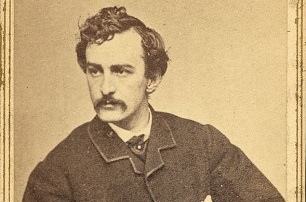 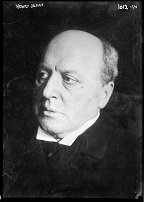 |
| Two of Emily's contemporaries, actor and Lincoln assassin John Wilkes Booth (left) and popular novelist Henry James - Library of Congress |
|
The old National Theatre in Boston Courtesy Wikimedia Commons |
...large, red in the face, coifed in a tangle of small, fine, damp-looking short curls and clad in alight-blue garment edged with swans-down, shout at the top of her lungs that a "purr-r-se of gold" would be the fair duerdon of the minion who should start on the spot to do her bidding at some desperate crisis that I forget... [She] gave form to my conception of the tragic actress at her highest. She had a hooked nose, a great play of nostril, a vast protuberance of bosom and always the "crop" of close moist ringlets; I say always, for I was to see her often again, during a much later phase, the mid-most years of that Boston Museum which aimed at so vastly a distinction than the exploded lecture-room had really done, though in an age that snickered even abnormally low it still lacked the courage to call itself a theatre. She must have been in comedy, which I believe she also usefully and fearlessly practised, rather unimaginable; but there was no one like her in the Boston time for cursing queens and eagle-beaked mothers; the Shakespeare of the Booths and other such would have been unproducible without her; she had a rusty, rasping, heaving and tossing "authority" of which the bitterness is still in my ears.
Some think that Henry had been impressed by Emily's ample breastline when playing a mulatto woman in Barnum's version of Uncle Tom's Cabin in the early 1850s. In one notable scene, she dramatically fled across a river on ice fashioned from wood.
Many years later, when James saw an older and enfeebled Emily on a Boston street, he wrote that she was "the very image of mere sore histrionic habit and use, a worn and wear, a battered ... thing of the theatre, very much as an old infinitely-handled and greasy violincello of the orchestra might have been."
Another observer, Joseph Norton Ireland, writing in the 1866 book Records of the New York Stage, said that:
Miss Emily Mestayer possessed a form most symmetrically proportioned, features of rare loveliness, a complexion of dazzling fairness, a voice of mingled power and sweetness, and a willingness to assume any range of character, that rendered her at once one of the most useful and personally attractive actresses known to our Stage. With the ability to throw considerable feeling in certain serious characters, and a skill in vocalism that always pleased an uncultivated ear, Miss Mestayer long maintained a distinguished popularity with the frequenters of the minor theatres, and still commands their highest approbation. With a higher grade of auditors, she possessed powers of fascination not easily resisted, yet a sameness in her personations soon palled upon those who sought some diversity in the portrayal of an entirely opposite class of characters.
| A Selection of Emily Mestayer's Stage Venues and Characters |
New Bowery Theatre on Elizabeth Street, between New Canal and Hester Streets The Maid of Munster, Kate O'Brien, 1860 Boston Museum Doctor of Alcantara, Donna Lucrezia Paracelsus, April 7, 1862 Grover's Theatre, Washington, DC Warren Comedy Combination, Sept. 5, 1864 James W. Wallack's Theatre, Broadway and 13th Street, New York Dearer Than Life, Mrs. Garner, Sept. 23, 1868 Money, Lady Franklin, Dec. 28, 1868 Caste, Marquise de St. Maur, May 3, 1869 The School for Scandal, Mrs. Candour, Sept. 15, 1869 New Men and Old Acres, Lady Matilda Vavasour, 1870 The Lancers, Mme. d'Aplomb, May 9, 1870 |
Wallack's (continued) The Red Light, or the Signal of Danger, Mrs. Holmes, June 6, 1870 Minnie's Luck, or the Ups and Downs of City Life, Cleopatra, June 27, 1870 Fritz, Our Cousin German, Metzler, 1870 The Rivals, Mrs. Malaprop, 1870 and 1871 The Two Roses, Mrs. Jenkins, Oct. 10, 1870 Romance and Reality, Barbara, March 2, 1871 The Liar, Miss Godfrey, April 13, 1871 Randall's Thumb, Miss Spin, May 8, 1871 Rosedale, May 29, 1871, Tabitha Stork, May 29, 1871 Her last known performance at Hallack's was on Sept. 30, 1871, reprising the character of Mrs. Malaprop in The Rivals. Source: A History of the New York Stage, by T. Allston Brown, 1903. |
Her last appearance in New York was at the Union Square Theatre, Dec. 18, 1873, playing the baroness in Led Astray. Her final stage performance was at the California Theatre, San Francisco, Aug. 8, 1878, in Diplomacy.
Emily's final residence was with the Kline family at 45 Seventh Avenue in New York, who had provided lodgings for her over the span of 35 years. In September 1881 she went to see her son Charles in California and there caught a cold. Upon her return to New York in April 1882, her health plummeted. Suffering from congestive lung failure -- "dropsy" -- she died on April 25, 1882 in New York, surrounded by her son and two daughters-in-law. She was laid to rest in Brooklyn's Green-Wood Cemetery. Her grave is not marked.
In an obituary, a newspaper said that:
There are few theater-goers of the present generation who have not somewhere on this continent, seen at least one membeer of the family to which the following notice refers. The theatrical career of Emily Mestayer began in Boston, if we are not mistaken, where the family resided for many years, and where they all appeared at the old National Theatre, on Hay-Market Square, at different times... Emily Mestayer, the once favorite actress, died in New York one day last week, in her 68th year. She was of French descent, and her father was an actor of considerable repute. All through her theatrical career she reserved her maiden name, even after her marriage to Dr. Charles Houpt, a leading dentist in California, where he died some twenty years ago, leaving her with two sons and two daughters. Her prediliction for the stage seemed an inborn instinct, and at an early age she appeared behind the footlights... Miss Mestayer's versatility enabled her to assume a wide range of character. She was for years the leading actress at Barnum's Museum, New York. For two or three seasons she played at Wallack's and also at the Union Square Theatre, and for years was the principal actress at the Boston Museum. Her last appearance was about eight years ago in Led Astray.
|
Elmhurst Cemetery - courtesy Lowell Pankake |
Son Dr. Charles Henry Houpt (1839-1894) was born on March 30, 1839. He entered into marriage with Harriet C. (1840-1892), an immigrant from England. They apparently did not reproduce. Charles was a physician, and the pair were in San Francisco circa 1880-1882. The federal census enumeration of 1880 shows the Houpts boarding in a San Francisco hotel kept by E.T. Stephenson. In December 1880, he was elected recording secretary of the Eclectic Medical Society of California at its annual meeting in the Palace Hotel. His mother is known to have spent the winter of 1881-1882 with them, only to catch a cold which led to her death back in New York. By 1883, the pair had relocated to St. Paul, MN where he continued to practice medicine in Brainerd. Sadly, Harriet passed away on July 2, 1892. A death notice in the St. Paul Globe said she was the "wife of Dr. C.H. Houpt of this city" and asked newspapers in Philadelphia, San Francisco and Washington, DC to reprint the obituary. Charles survived his wife by two years. Death carried him away in Rochester, MN in 1894. The couple sleeps for the ages in St. Paul's Elmhurst Cemetery.
|
William Mestayer - Wikimedia |
Theresa got her start at the age of 12 when singing in a Catholic church choir. It's said that the first stage role of importance was as a French maid, making "an instant hit," said the Boston Globe. She was fluent in German, French and Italian, with "a pure, rich and sweet contralto." Her first marriage, to Boston's Barney Hull, ended in divorce. One of her greatest performances was an old street ballad, "Annie Rooney," that she brought back to live in the German tongue.
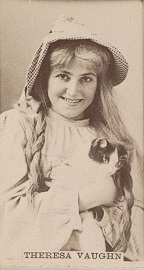 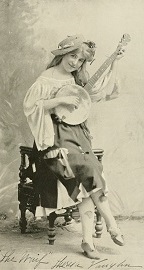 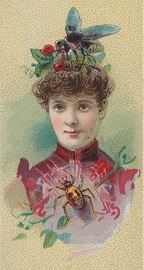 |
| Images of Theresa Vaughn, above, on cards issues by Sweet Caporal (left) and Honey Bee Duke (right) cigarettes. Below, her portrait on popular sheet music of the era, The Belle of Poverty Flats and Love, Sweet Love. Courtesy Wikimedia Commons |
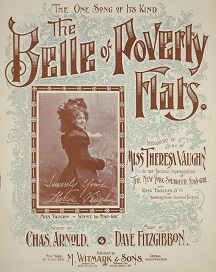 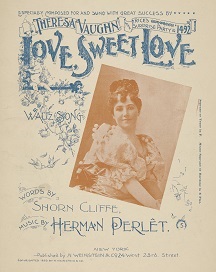 |
Finding his place with the California company, he remained until about 1878, starting as a subordinate and moving up to a "first low comedian," playing Mr. St. Paul in Baby. In about 1878, he went to San Francisco for a successful, 16-week role in E. Rice's Surprise Party. From that time on he regularly drew large audiences in gigs across the country. Among the hit shows in which he starred were Horrors by William Gill, Babes in the Woods by H.J. Byron, Robinson Crusoe and Revels. In 1879, he acted in a seven-week performance at New York's Union Square followed by a five-week engagement in Boston. He was extensively profiled in a July 27, 1879 Brooklyn Eagle article about the troupe in which he was performing under controversial manager John P. Smith. The story said that William "belongs to a family greatly celebrated as actors and actresses," and that his character, T. Henry Slum, was "a commercial traveler, the Train Guerilla, an old swell, with Mestayer's original song of 'Tum, Tum, Caper' and female impersonations... He is a large, finely built man, a capital burlesque actor and only needs a good character part to make a decided hit." William and Theresa traveled to London in 1890 where she was to sing under contract to D'Oyly Carte to sing in The Gondoliers at the Savoy Theater. He made news in the New York Times in 1895 when playing a part in Oliver Twist at the American Theatre with Elita Proctor Otis, Charles Barron and Katherine Dooling. William and Theresa maintained a home in New York and summered at Red Bank, NJ. Sadly, suffering from incurable kidney disease, William died in New York City on Nov. 21, 1896. Funeral services were conducted in the Little Church Around the Corner. One obituary appeared in the Red Bank Daily Register. Another, in the Harrisburg Telegraph, said that he:
...has made more people laugh than perhaps any other actor of this age... Some years ago, when Mestayer and his charming wife, Theresa Vaughn, were playing in this city, Mr. Mestayer remarked in the office of the Bolton House that he ought to be familiar with Harrisburg as he was born here and played in the vicinity of Second and Mulberry with the boys of the neighborhood. Mr. Mestayer was the author of the play of Tourists in a Pullman Car, the most original of all farce comedies, and which netted him a fortune. He was a remarkable character actor, ranking with Dixey in that respect, and his impromptu wit and the funny things he said in a play that were not in the text were simply inimitable. He was the inventor of more clever bits of slang than any man in the country. The expression "It's a cold day when I get left," which still has a vogue, was one of his inventions, and his contributions to picturesque and grotesque contortions of the American language were very large.
Theresa went to pieces after her husband's death. She tried to continue to act but, with her memory in decline, was unable to keep up with memorizing scripts and stage movements. She retired from the theatre in late 1899 and went to Chelsea, MA to live with her mother at 145 Cherry Street. Already deeply depressed, she received a further blow at the loss of her brother Joel Ott. Then in April 1901, at the age of 36, she was admitted to the Worcester Asylum for the Insane. In a related story the Boston Globe reported that:
The patient has not been violent at any time, and says she is only suffering from nervousness. She went to the institution willingly, and expects to return home improved in health before long. Her physicians, however, hold out little encouragement of her recovery. Her friends are not ready to believe that she will not be herself again. She has been melancholy, and has threatened to commit suicide. She was taken to the asylum last Thurday by officer Hutchinson of the Chelsea court... She had a prominent part in "1492" a few years ago, and was a favorite singer in light opera for a number of years.
The Pittsburgh Press also printed a story about her decline, saying she had:
...appeared in many notable productions, one of which was "The Grab Bag" at the Old Park theater (now the Herald square) New York, where she introduced her famous yodling song which was afterward introduced in Rice's "1492" and made the actress and piece famous. Probably the most widely known creation of Miss Vaughn's was her "Fiddle and I" song which was one of her earliest successes and many times she has rendered it as an encore after rendering songs of the day, while theater goers will remember with pleasure her rendition of the old song in German. Miss Vaugh's last starring tour, prior to her vaudeville debut, was under the management of Frank Connelly, the present business representative of the Grand Opera House, this city. About two years ago Miss Vaughn appeared with the Grand Opera House Stock company, essaying the leading roles in their productions, but was forced to quit on account of her mental collapse.
She stayed in the asylum for over two years and was considered to be a "mental wreck... incurably insane" and "fast failing," according to news reports published across the nation. Newspaper stories at the time said that after Mestayer's death, she had wed "Theodore Haupt" and that it was his death in 1898 that precipitated her decline. She succumbed to the spectre of death on Oct. 4, 1903. An obituary in the Fall River (MA) Globe said the cause of her death was "paresis" -- a loss of muscle control. It added that "If theatregoers who have poor memories for names will go back to the days when that light frivolity, '1492,' was a reigning attraction, they will probably remember a dark-haired girl who, with no other accompaniment than a mellow toned banjo, sang simple little ballads in a sweetly sympathetic contralto voice. That was Theresa Vaughn." She was pictured in an obituary in the Boston Globe, which noted that "Of the thousands who heard the ballad singing of Theresa Vaughn, probably not one in a hundred failed to appreciate her peculiar charm. She was the ballad singer without compare, within the limits of her chosen work. Brilliancy and technique in singing she left to others, for she had a more valuable attribute to the singer's art, the power to touch the hearts of her hearers with a direct appeal of her voice and manner to their tenderest sympathies."
She lies in eternal repose in an unmarked grave in Holy Cross Cemetery and Mausoleum in Malden, MA.
Today, Charles' name is included on an official California Historical Landmark plaque at 444 Bush Street in the Financial District, marking the site of the California Theatre, built 1869, demolished and rebuilt 1889, and ultimately destroyed in 1906 in the Great San Francisco Earthquake.
~ Daughter Henrietta Bennett (Haupt) Archambault ~
Daughter Henrietta Bennett Haupt (1821-1913) was born on April 6, 1821.
On Dec. 6, 1848, she married Achille Lucien Archambault ( ? -1908), son of Joseph Oliver Victor Senez Archambault of Newtown, Bucks County. Achille's father is said to have been an aide to French Emperor Napoleon Bonaparte and accompanied him to St. Helena, said the Philadelphia Inquirer, "and it was he who broke his sword over his knee and threw the pieces into the sea to prevent his British captors getting it."
Five offspring born to the pair were Joseph Lucian Archambault, Thomas Jefferson Haupt Archambault, Charles Victor Archambault, Anna "Margaretta" Archambault and Achille Lucian Archambault. They grieved when their eldest son Joseph died in 1851 at the age of under two.
Achille founded the Kensington Iron Works Company and Kensington Engine Works. He is widely credited with having invented the first portable engine in the United States and in designing the first steam yacht in action in American waters.
When the couple marked their golden wedding anniversary on Dec. 6, 1948, they held a reception at their home at 426 South 40th Street, with a notice published in the Inquirer. Among those helping in receiving guests were Isabel M. Harrison, Bessie Haupt, Florence Haupt and Susie Haupt. Guests included Mr. and Mrs. B.K. Jamison, Mr. and Mrs. Norton, Mrs. Ash Shaffer, Mrs. Lewis M. Haupt, Professor and Mrs. Jones, Mrs. Henry Heyl, Mr. and Mrs. E.S. Levy, Mrs. Barrett, Mrs. Harrison, Mrs. George Jenks and Mrs. Howard.
The celebration was short-lived, as Achille died 22 days later, on Dec. 28, 1908. His death created headlines in newspapers across the nation.
Henrietta lived on for another five years. Burdened with hardening of the arteries, she passed away at the age of 92 on Sept. 16, 1913. Burial was in Woodlands Cemetery. A miniature portrait of Henrietta, by the painter Thomas E. Barratt, was loaded by daughter Margaretta to the Pennsylvania Academy of Fine Arts for an exhibition celebrating the 25th anniversary of the Pennsylvania Society of Miniature Painters.
Son Thomas Jefferson Haupt Archambault (1852-1941) was born on April 6, 1852. He did not marry or reproduce. He assisted his father in the operation of the Kensington Iron Works Company. Circa 1899-1900 he served as commissioner of the Nicaragua Canal and director of irrigation projects in Arizona. His final residence in the City of Brotherly Love was with his sister 426 South 40th Street. He died at the age of 89 at home in Philadelphia on April 14, 1941. An obituary in the Philadelphia Inquirer confirmed his father's relationship to Napoleon. Interment was in Woodlands Cemetery.
Son Charles Victor Archambault Sr. (1854-1943) was born on March 11, 1854. In 1895, he married Julia Virginia Richardson (1873-1953). the ceremony was led by Rev. Thomas J. Kenny of the St. Mary's Star of the Sea Church, held in the home of the bride in Baltimore. Together, they produced a family of four -- Virginia Parrott (1896-1999), Winifred Border (1897-1976), Charles Victor Archambault, Jr. (1899-1973) and Thomas Julian Archambault (1901-1986) . He spent his career as a marine designer. The Archambaults dwelled in Baltimore in 1940-1941. Charles died in Rhode Island at the age of 89 on Aug. 24, 1943. Burial was in Baltimore's New Cathedral Cemetery, following a requiem mass at St. William's Church, with an obituary appearing in the Baltimore Sun.
|
Margaretta's 1924 book Courtesy Google Books |
Son Achille Lucian Archambault (1866-1940) was born on Jan. 18, 1866. He was wed twice. His first marriage, on Oct. 8, 1890, to Mountain Lake Angel ( ? -1891) only lasted a little more than a year. She was spirited away by death on Nov. 8, 1891. On Feb. 1, 1895, he wed a second time to Margaret Chapman Angel ( ? - ? ). The second union resulted in five children, among them Achille Lucien Archambault III and Marguerite Chenery Stewart. He held memberships in the Pleasant lodge of the Masons and Elks, the United Commercial Travelers, the Benevolent League TPA and was secretary-treasurer of the Travelers Protective Association. Achille made a home in 1916 in Ashland, VA and in 1940 at 430 Mountain Avenue Southwest in Roanoke, VA. He died on March 9, 1940, with the body shipped to Philadelphia for burial. An obituary was published in the Roanoke World-News. Their son Achille III (1896-1974) wed Louise Josephine Belcher (1897-1981). Their daughter Marguerite (1894-1994) was twice-wed, first to Charles Morris Chenery ( ? -1948). They did not reproduce. Charles was an executive with New York Water Service Company, Western New York Water Company of Buffalo, South Ban Consolidated Water Company of Long Island and Rochester and Lake Ontario Water Service Corporation of Rochester, NY. Circa 1948, the Chenerys dwelled in Upperville, VA, and he served as a vestryman for Emmanuel Church of Middleburg. Charles died at the age of 59, from a heart attack, on March 1, 1948. Then on Feb. 16, 1952, in Clearwater, FL, Marguerite married again to James "Frederick" Martin Stewart (1879- ? ) of Toronto. Their nuptials were held in the Episcopal Church of the Ascension, by the hand of Rev. Robert M. Man, with her hand given by Joseph T. Lykes, and announced in the Tampa Tribune. The Philadelphia Inquirer announced the marriage and said the pair would "spend most of the winter and spring" in Florida and "then make their home in Toronto." Their address in Clearwater was 1617 Drew Street and Toronton at 7 Beaumont Road. Frederick was the son of James Archibld Stewart of Harriston, Ontario, an alumnus of the University of Toronto and president of J.F.M. Stewart and Company, Ltd. A collector of fine art, Marguerite made a number of donations over the years to the Corcoran Gallery of Art in Washington, DC. Among these were John Neagle's oil portrait of her great-grandmother Anna Margaretta Haupt as well as William E. Winner's Landscape and Self-Portrait and Frederick Judd Waugh's The Open Sea. and a plaster bust of her brother Achille III, fashioned by Alexander Sirling Calder, all today part of the National Gallery of Art. Funds she provided to the Virginia Museum of Fine Arts were used to help purchase Charles Hoguet's Shepherds and Their Flock Resting Under a Tree. She is known to have spent the winter of 1974 at Aiken, SC, a place which her friends persuaded here was the "direst spot east of the Rocky Mountains" with "crisp, clean air," said the Aiken Standard. During that holiday, she stayed at Hankinson Cottage and then moved to Charleston. She told the Standard that she "has no connection with the horse industry; she is in the cattle business, raising black Aberdeen Angus steer. Her [first husband's] niece, however, is Helen 'Penny' Tweedy, the former owner of Secretariat." Marguerite died on July 11, 1994, just 11 days shy of her 100th birthday. Her remains are in eternal sleep in Woodland Cemetery in Ashland, VA.
~ Son Dr. Thomas Jefferson Haupt ~
Son Dr. Thomas Jefferson Haupt (1823-1856) was born on the Fourth of July 1823 and apparently named for the author of the Declaration of Independence who was still living at the time.
He was a medical doctor and practiced dentistry. Circa 1844-1845, at the age of 21, he was based in Philadelphia at 201 North Sixth Street, between Callowhill and Wood, and advertised daily in the local newspaper, the Philadelphia Public Ledger.
By 1846, he had an office at 148 Lexington Street in Baltimore, MD, and was planning to travel to Gettysburg, where he brother Herman was residing, to provide dental services there. As of 1850-1851, his practice had moved to 308 Broadway, and he advertised in the New-York Daily Tribune that the "Dental operations performed at this office are characterised by elegance, permance and excellence of materials; charges barely remunerating and much below the usual rates. A visit from those whose limited incomes have heretofore prevented them from employing a competent Dentist is respectfully solicited."
 |
| Above: Dr. T.J. Haupt was on the George Law when he drowned at sea in 1856. Library of Congress. Below: His memorial in Laurel Hill Cemetery. Courtesy Russ Dodge |
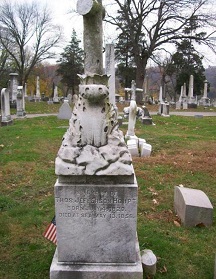 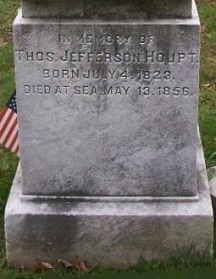 |
He is known in May 1856 to have sailed aboard the steamer George Law, carrying U.S. postal mail and millions of dollars in gold, en route from San Francisco to New York via Aspinwall, Panama. Tragically, on May 13, 1856, at the age of 33, he drowned while on that trip, three days before the ship was to have arrived in New York. His body was not recovered, and no newspaper coverage or obituary have been found.
His death may have been overshadowed by a far greater tragedy on that voyage. While docked in Panama, a week earlier, a number of George Law passengers boarded a Panama Railroad express train and some 30 to 40 were killed when the locomotive derailed at the Obispo Bridge, generating worldwide reportage. A cenotaph tablet was erected in Thomas' memory on his mother's grave in Philadelphia's Laurel Hill Cemetery.
~ Son Jacob "Lewis" Leeds Haupt ~
Son Jacob "Lewis" Leeds Haupt (1826-1898) was born on April 20, 1826 in "old Philadelphia" and was said to have been of English, German and Huguenot bloodlines.
He was a graduate of Boys' High School in the city. When his brother Herman was named professor of mathematics and engineering at Pennsylvania College in Gettysburg, and founded the Oakridge Select Academy in town, he hired Jacob as as teacher in the school, perhaps also known as the Oak Ridge Seminary for girls. Not long afterward, said the Lancaster (PA) Semi-Weekly New Era, "during the presidency of the Pennsylvania Railroad Company of Mr. John Edgar Thompson, he was appointed the general passenger and ticket agent of the newly organized enterprise, with headquarters first at Harrisburg and afterwward at Philadelphia; and was well acquainted with all the workers, officers and conductors of the passenger department of the entire road, which he brought to a state of splendid efficiency. He was largely the originator and promoter of that great convenience to all modern travelers, the 'coupon' ticket, and was a conscientious, steady worker, traveling incessantly for the road. So important an officer was he to the system that when he was 'drafted' during the Rebellion, near the close of the fifteen years of his service, his fine was promptly paid by the railway in order to retain him at his post of duty, and secure the faithful transfer and forwarding of the troops, from the West and North, over this great system. The work over which he then presided has now become three great departments of the road. Mr. Haupt subsequently entered upon a mercantile life and was interested in the mining, shipping and delivery of coal. He was also President of the North American Life and Accident Insurance Company of Philadelphia."
 |
| Philadelphia: A History of the City and Its People, by Ellis Paxson Oberholtzer Courtesy Internet Archive |
On April 1, 1885, he accepted a new position as superintendent of the Visitation Agency of the Glen Mills School or House of Refuge, located at the corner of Parrish and 23rd Streets in the city, and maintained that position for the balance of his years. Said the New Era, "And it it safe to say that the thousands of his 'boys' and 'girls' of this great charity were the better for having come into contact with his noble character and self-denying care."
For decades, both in Philadelphia and Harrisburg, he was active in eldership and Sunday School roles and in time was named president and treasurer of the church council of St. Mark's Lutheran Church in the city of brotherly love. He also held posts as secretary of the Lutheran Orphans' Home at Mount Airy and helped to organize the city's Lutheran Theological Seminary, where he sat on its board from 1867 to 1885 during a time when the school produced five Lutheran pastors who went on to serve pulpits in Lancaster.
The New Era said that "Of a quiet, unassuming nature, he never sought or held public office, yet he ever lived for others and was a most self-denying, useful man. He was always ready when called upon to lend a helping hand. The entire ticket system of the great Sanitary Fair was under his supervision and management. Always at his post of duty, honorable, chaste, reliable, thorough in all he undertook, careful, but fixed in his convictions, a ready writer, with a rich vein of wit and a keen sense of humor, earnestly, deeply spiritual and morally devout, systematic, patient and persevering, the enemy of all that looked like tyranny, cant, or hypocrisy, he stood as the embodiment of a true Christian and American churchman and civilian... In person Mr. Haupt was small and of gentle winning manners."
In 1849, he wed Louisa Caroline Keller (July 30, 1828-1918), daughter of Rev. Dr. Benjamin Keller. (Lewis' brother Herman wed Louisa's sister Ann Cecilia.) Their family of five children included Rev. Charles "Elvin" Haupt, Henry Eugene Haupt, William Keller Haupt, Fanny Gertrude Haupt snd Mary Louise Conarroe.
While on a visit to the home of his son Elvin in Lancaster, PA in late August/early September 1898, his health failed due to what a newspaper called a cause of "a scirrhous nature." He passed away at the age of 72 on Sept. 17, 1898. The Semi-Weekly New Era reported that "As midnight approached on saturday last the spirit of Mr. Lewis L. Haupt passed from its earthly state and found peace." The remains were brought back to Philadelphia for funeral rites at the family home at 1724 Park Avenue. Delivering the funeral oration was Rev. J.L. Sibole, assisted by Rev. Ashmead Schaffer. Pallbearers were Richard A. Leweis, Amos Bonsall, W.W. Kurtz and Benjamin N. Faires. The remains were interred in Laurel Hill Cemetery.
Louisa outlived her spouse by two decades. Toward the end she became senile and developed heart disease. She remained in Philadelphia at 1724 North Park Avenue and died there at the age of 90 on Sept. 30, 1918. An obituary in the Lancaster (PA) Intelligencer said she "was a most active Christian woman in her day and was well known here." Burial was in Laurel Hill Cemetery.
Son Rev. Dr. Charles "Elvin" Haupt (1852-1920) was born on Oct. 6, 1852 in Harrisburg, Dauphin County, PA. He grew up in Philadelphia, graduated from its public school system and attended a private academy. In 1868, at the age of 16, he enrolled in the University of Pennsylvania and graduated with a classical degree in 1872. Elvin made the decision to enter Christian ministry and graduated in 1875 from the Lutheran Theological Seminary on Franklin Square. On Jan. 15, 1878, he wed Mary Martha Geissinger (Sept. 22, 1846-1920), daughter of John Geissinger of Huntingdon County. The couple's duo of known children were Charles Elvin Haupt Jr. and Gerald Lewis Haupt. They quickly established their permanent residence in Lancaster, PA, where he launched his career at Christ Lutheran Church, at that time a mission of Old Trinity, as an assistant under Rev. Dr. Greenwald. For many years he was a principal at Franklin and Marshall College and a professor of mental and moral philosophy. He and his cousins Rev. Alexander James Derbyshire Haupt and Rev. Lewis Muhlenberg Haupt were profiled in Rev. J.C. Jensson's book American Lutheran Biographies (Milwaukee, 1890).
Since he entered on his residence in Lancaster, Pa., Sept. 1, 1875, as Dr. Greenwald's assistant, the Rev. Charles Elvin Haupt has seemed a vital part of Lancaster and its Lutheranism... His youth was spent in Philadelphia. After graduation at the University of Pennsylvania of that city and the Philadelphia Theological Seminary, he was ordained by the Ministerium of Pennsylvania at Norristown, May 26, 1875. His duties as assistant to Dr. Greenwald lay especially in that portion of Holy Trinity parish where Christ Church had been erected. He was a man exactly to the Doctor's mind – in many things a copy of the mild, engaging old pastor, and has since succeeded to his local popularity among people of every rank, notably among the poor and distressed. In January, 1880, he became pastor of Grace Church, in the northern part of the city. Fruits of his work there are a small parish school, quite a rarity in English churches, and the Greenwald memorial mission, called "The Evangelical Lutheran Sunday School of Emmanuel.” He is the author of "Stories from Bible History," and a biography of Rev. Dr. Greenwald. His skill in music and drawing, and his acquaintance with most of the natural sciences, added to a ready flow of genial humor and an abundant store of apt anecdotes and illustrations, make him a valuable adjunct at Sunday School institutes and wherever children or youth are to be interested in the affairs of God's Kingdom.
He also was known as a witty user of puns, and widely known as a workaholic. The Lancaster Examiner once said that "For many years he persistently refused to take a vacation, until several years ago, he was sent on a Western strip to the Pacific coast, and he returned greatly refreshed. Whenever the subject of vacation was broached, he emphatically declared that the church must be kept open." Elvin was named in 1880 as the second pastor of Lancaster's Grace Lutheran Church and held that post for four decades to the end of his life. All told, he performed 3,500 weddings and more than 4,000 funerals. He received a doctoral degree in 1900 from Franklin and Marshall. During his pastorship at Grace, when a new building was constructed in 1908, a "singing tower" of a 15-bell chime was installed and still functioning as of 2000. During the 1908 construction era, the members worshipped at the Temple Shaarai Shomayim on the same block, having always had a cordial relationship, including a "joint Thanksgiving service at the temple for which some of Haupt's colleagues roundly criticized him," said the Intelligencer Journal. He was a founder of Lancaster General Hospital and Madame Cotta College, later reorganized into the Shippen School for girls and renamed the Lancaster Country Day School. The Journal said that the Lemon Street Public School, later the Lancaster General Hospital School of Nursing, was renamed the Haupt School and stayed that way until the 1990s. At the death of his mother in 1918, in Philadelphia, he traveled to attend the rites and had to forego leading his usual midweek services. His address in 1920 was 21 East James Street in Lancaster, a residence known as "Grace Place." Suffering from chronic heart disease and acute kidney failure, death swept him away just eight days after his 68th birthday on Oct. 14, 1920. Charles E. Haupt Jr. of Washington, DC signed the official state death certificate. Burial was in Woodward Hill, also known today as Greenwood Cemetery. The city is said to have paid for a prominent marker at his grave. Inscribed on its face is this epitaph: "A fervent preacher of God, a loving disciple of Jesus Christ, a faithful servant of his fellow-men, came not to be ministered unto but to minister." Today, the carved letter "H" is in his honor remains in a rectangular stone as part of an old three "carriage-steps" platform in front of the church parsonage at 21 East James Street, Lancaster.
- Grandson Charles Elvin Haupt Jr. moved to Washington, DC where he was an architect.
Son Henry Eugene Haupt (1855-1925) was born on June 30, 1855. On April 15, 1880, he wed his cousin, Mary Ella Witte (1849-1921), daughter of William H. and Mary Ann (Haupt) Witte of Bucks County. The couple did not reproduce. Circa 1898, when named in his father's newspaper obituary, he worked as a scales manufacturer. Their address in the early 1920s was 225 South 40th Street. Sadly, Mary Ella died at home on March 25, 1921. An obituary in the Philadelphia Inquirer said she was "well known in musical circles in this city... [She] was an alumna of the Moravian Seminary at Bethlehem, a charter member of the Philadelphia Choral Society, the Philadellphia Music Club, associate member of the Fortnightly Club and connected with other musical interests here." Her funeral rites, conducted in the residence, were presided by Rev. J. Henry Harms, of the Lutheran Church of the Holy Communion. The widowed Henry then went to live at 4521 Spruce Street. On March 22, 1925, at the age of 69, he died from the effects of pulmonary tuberculosis. The body was laid to rest in Laurel Hill Cemetery. No obituary has been found in the Philadelphia Inquirer.
Son William Keller Haupt (1857-1939) was born on Oct. 11, 1857. He was married three times during his lifetime and is not known to have reproduced. His first marriage was with Rachel Sweetman ( ? -1904). William was employed in the bankfield field for more than 50 years. In 1887, he joined the employ of the Union National Bank. By 1898, he had moved to the Fourth Street National Bank, remaining until 1900. He then was tapped to be vice president of Colonial Trust Company, a position he held in 1905 when mentioned in the Philadelphia Inquirer obituary of his famed uncle, Brig. Gen. Herman Haupt. He became a partner in Altemus and Haupt, brokers. For five years, reported the Inquirer, he was the Philadelphia representative of the commercial paper brokerage firm of Lahey, Fargo and Company of New York. He also was "widely known as a singer" and performed solos as a tenor at the North Broad Street Presbyterian Church and the First Unitarian Church. William held memberships in the vaunted Union League, Bachelors Barge Club, Orpheus Club, Symphony Society, Melody Club and Matrinee Musical Society. He also served a term as treasurer of the Geographical Society of Philadelphia. Sadly, Rachel died on Dec. 7, 1904. His second spouse was Sarah Lombaert (1857-1921). He is known to have signed his mother's death certificate in 1918 and at the time lived at 119 South Fourth Street. Then on June 19, 1922, he tied the marital knot with Anna (Thompson) Wood (1886-1957). The couple shared a home at 2112 Spruce Street. In November 1937, William was stricken by a severe cerebral hemorrhage but did not die. He lingered for about 16 months. During that time, at Christmas 1937, some 37 members of his Orpheus Club came to his home to serenade him with holiday carols. Said the Inquirer, "The affair attracted so much attention the police roped off the space in front of the Haupt home and the Orpheus then delighted the neighborhood with an outdoor concert. Mr. Haupt became a membere of this top-ranking Philadelphia singing club about 50 years ago." Death mercifully carried him away at the age of 81 on Feb. 21, 1939. He succumbed to the spectre of death in Philadelphia on Feb. 21, 1939. The remains were interred in Laurel Hill Cemetery.
Daughter Fanny Gertrude Haupt (1862-1947) was born on June 20, 1862. She did not marry over her long life. In the 1940s, she dwelled at 270 West Walnut Lane in Philadelphia. As her health declined she was admitted to resided in the Conner Convalescent Home. Diagnosed with cancer of the lung and a leasion on the right breast, which spread, she surrendered to the angel of death on April 24, 1947. Her mortal remains were lowered under the sod of Laurel Hill Cemetery in Philadelphia.
Daughter Mary Louise Haupt (1864-1906) was born on Jan, 24, 1864 or 1865. At the age of 28, on Oct. 19, 1892, she wed Richard Riley Conarroe (1863-1930), also commonly spelled "Connaroe" and "Conarrol," the son of John L. and Margaret (Hamm) Conarroe. Their nuptials were held in St. Luke's Evangelical Church in Philadelphia, officiated by Mary Louise's brother Rev. C. Elvin Haupt, assisted by Rev. J. Luther Sibole. In announcing the marriage, the Philadelphia Inquirer said that the "bride was attired in white crepe de chene, en train, trimmed with embroidered chiffon. She wore diamond ornaments, a tuile veil, with orange blossoms and white kid gloves and bore a bouquet of bridal roses." Afterward, the wedding banquet was held at the home of her parents at 1724 Park Avenue. Six children were produced by this union -- Elvin Hamm Conarroe (1896-1953), Richard Riley Conarroe Jr., Margaret Louise Conarroe (1893-1966) and triplets Louis Conarroe, John Conarroe and Elizabeth Conarroe. The Conarroes lived in Philadelphia where Richard earned a living as a hardware store merchant. He is known to have become a partner of the hardware firm James M. Vance & Co. in January 1902 along with H. Vance Peters and Edmund L. Wunder. Their homeplace was at the address of 2033 North 22nd Street. Tragically, while expecting a baby in late 1905, Mary Louise developed kidney problems which plagued her for the remaining six months of her existence. Then, after giving birth to not one baby but three, in mid-March 1906, her health plummeted. A week after birth, death spirited her away at the age of 41 years, two months and two days on March 26, 1906. Adding to the family's overwhelming grief, one of the triplets, Elizabeth, was stillborn. Funeral services were held in the family home, with burial for Mary Louise taking place in South Laurel Hill Cemetery and baby Elizabeth in the Odd Fellows Cemetery. A very brief notice of her death was printed in the Philadelphia Inquirer. The widowed Richard outlived his bride by nearly a quarter of a century. He wed a second time circa 1907 to Pansy D. Ottwell (1884-1946), daughter of Mary Ottwell. His final employer was Charles M. Ghriskey's Sons. Their home in 1930 was the Chelton Arms Apartments in Germantown. He passed away in Germantown Hospital at the age of 66 on Feb. 2, 1930. An obituary appeared in the Inquirer. Daughter Margaret Louise did not marry. She lived in Bryn Mawr, PA where she was employed as an executive secretary, and died from colon cancer on April 7, 1966.
~ Daughter Mary Elizabeth Haupt ~
Daughter Mary Elizabeth Haupt (1828-1867) was born on Aug. 3, 1828.
She never married but devoted her life to her career. When her brother Herman was named professor of mathematics and engineering at Pennsylvania College in Gettysburg, he arranged to have Mary hired to a faculty of three at the Female Seminary. The faculty's focus was on religion, health, social and domestic responsibilities and cultivation of the intellect.
The Philadelphia Evening Telegraph said Mary was "One of the first teachers in the Girls' High and Normal School, when that institution was reorganized on its present basis, [and] was placed in charge of the department of Mental and Moral Philosophy. As a teacher she had few equals and no superiors, and in the latter branch exemplified her teachings by her daily walk and conversation."
Circa 1866, she dwelled at 2029 Green Street, Philadelphia. When in her 30s, she left the high school to join Mary E. Tazewell as principals of the West Penn Square Seminary for Young Ladies at 5 South Merrick Street, on West Penn Square below Market. The Evening Telegraph said the seminar "bid fair to become one of the best and most popular of its character in the city." They are known to have placed advertising in the Philadelphia Inquirer in 1866 and 1867 announcing when the next terms would begin and instructing parents on deadlines for applications. Mary also was a member of St. Philip's Protestant Episcopal Church.
In July 1867, she and Mary, in company with Josiah W. Harmer, Mr. and Mrs. Clark and Rev. Robert G. Chase and his wife, took a holiday to the coast of Maine. At the time, Chase was rector of St. Matthias Episcopal Church of Philadelphia, while Harmer was an up-and-coming lawyer and Clark was the cashier of the Framingham National Bank of Massachusetts. On the tragic day of July 24, 1867, while yachting together in Bar Harbor near Mount Desert, all but one in their immediate party drowned when their vessel capsized in a sudden burst of wind. The Philadelphia Evening Telegraph said that on the day of the outing:
They were a pleasant and happy company, and were enjoying themselves to the utmost. The last words spoken were by Mr. Chase, who stood upon the mast, "On, this is glorious." In a moment the squall struck them, and they were buried in the ocean depths. Verily, "in the midst of life we are in death." Those who were in the other boat saw the disaster with feelings that can better be imagined than described, but they were two miles and more to leeward, and could in no way reach the spot. Miss Blake, of Framingham, who was rescued, has recovered, but is still here. Her life was saved by an oar which she clutched, and by which she was buoyed up till help could reach her. Other bodies were seen floating on or just below the surface, but it was impossible to reach them. The boat went down stern foremost, dragging the smaller boat in tow with her, and disappeared almost instantly. The most strenuous efforts have since bee nmade to recover the bodies, but without success. The water is forty or fifty fathoms deep, and the current is very strong. It is hardly probable they will ever be recovered till the sea shall be compelled to give up its dead.
 |
| Mary E. Haupt and friends drowned off the coast of Mt. Desert Islane, Maine |
A special report to the Portland Daily Press in Maine gave more details --
A party came in from Southwest Harbor about half past eleven in the sail boat Telegraph, owned by Mr. Freeman of Southwest Harbor, and piloted by one Robinson... They remained about an hour and put out again with another boar that had accompanied them, in charge of Mr. John Freeman. Two other boats started out soon after, one in charge of a Capt. Higgins, and the yacht Maggie Mitchell. We were badly baffled by flaws in getting out of the harbor. The Telegraph and her companion boat, however, were getting on well. All the boats were separated by the distance of a mile or more. When the Telegraph was about four miles out squalls began to strike us. The Telegraph was seen to careen, but then righted again, partially, at least. Another squall, and she was seen to go over, and in three or four minutes she went down. Capt. Higgins, who was nearest and had the best course, reached the spot first. It may have been 15 or 20 minutes. Four persons were seen floating upon the surface. Not a trace of the boat was seen. She had gone down so rapidly that no on seems to have had time to loose and launch the small boat, the and pilot had gone with her.
|
Lewiston Journal, 1867 Courtesy Google Books |
In its own analysis of the accident, the Philadelphia Inquirer observed that the:
...sad catastrophe... continues to be the subject of much comment and regret... These ladies were the companions of Mr. and Mrs. Chase upon their summer excursion. Miss Houpt was a sister of Lewis L. Houpt, Esq., the former General Ticket Agent of the Pennsylvania Railroad and at the present time President of the North American Accidental Insurance Company. He will feel the blow sadly... This calamity should be a warning to that class of careless persons who, forgetting or not realizing their ignorance and inexperience in such matters, will bathe, boat and sail in the most reckless manner. Accidents of this kind frequently occur, and though for a time they have some slight influence in checking the method of seeking dangerous pleasure. The caution is soon forgotten. A disaster, however, as severe as this, and one which has caused a deep gloom to settle not only on the immediate friends of the unfortunates, but also on many others, cannot fail to produce a full and good effect.
The news was published as far away as Pittsburgh, PA and Lawrence, KS. A cenotaph in Mary Elizabeth's memory was placed in Philadelphia's Laurel Hill Cemetery on the same marker as a similar tablet for her brother Thomas Jefferson Houpt, lost at sea in 1856, and their mother.
The operation of the school continued under the leadership of Mary S. Mitchell and Renee N. Townsend. Agnes Irwin became its head in 1869 and changed its name to the Agnes Irwin School, and then in 1875 moved it to her home at the southeast corner of Spruce and 19th Streets. In October 1898 -- 30-plus years after the tragedy -- a tablet to the memory of the two Marys was on exhibition at the Thackera & Co. on Chestnut Street during Jubilee Week.
Copyright © 2023-2024 Mark A. Miner Research for this page conducted by Della Shafer and the late Donna (Younkin) Logan |
